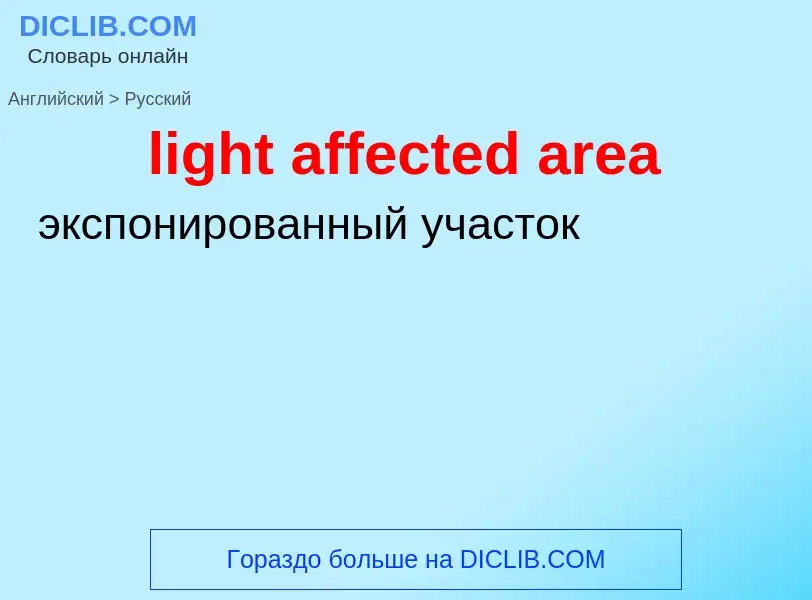Tradução e análise de palavras por inteligência artificial
Nesta página você pode obter uma análise detalhada de uma palavra ou frase, produzida usando a melhor tecnologia de inteligência artificial até o momento:
- como a palavra é usada
- frequência de uso
- é usado com mais frequência na fala oral ou escrita
- opções de tradução de palavras
- exemplos de uso (várias frases com tradução)
- etimologia
light affected area - tradução para russo
- closed area
- controlled area
- controlled access area
- fenced area
- fingerprint pattern area
- high risk area
- inaccessible area
- key area
- limited area
- logically protected area
- monitored area
- physically protected area
- protected area
- restricted area
- secret area
- secure area
- secure storage area
- security-sensitive area
- survey area
- target area
- user area
Wikipédia

In fusion welding, the heat-affected zone (HAZ) is the area of base material, either a metal or a thermoplastic, which is not melted but has had its microstructure and properties altered by welding or heat intensive cutting operations. The heat from the welding process and subsequent re-cooling causes this change from the weld interface to the termination of the sensitizing temperature in the base metal. The extent and magnitude of property change depends primarily on the base material, the weld filler metal, and the amount and concentration of heat input by the welding process.
The thermal diffusivity of the base material plays a large role—if the diffusivity is high, the material cooling rate is high and the HAZ is relatively small. Alternatively, a low diffusivity leads to slower cooling and a larger HAZ. The amount of heat input during the welding process also plays an important role as well, as processes like oxyfuel welding use high heat input and increase the size of the HAZ. Processes like laser beam welding and electron beam welding give a highly concentrated, limited amount of heat, resulting in a small HAZ. Arc welding falls between these two extremes, with the individual processes varying somewhat in heat input. To calculate the heat input for arc welding procedures, the following formula is used:
where Q = heat input (kJ/mm), V = voltage (V), I = current (A), and S = welding speed (mm/min). The efficiency is dependent on the welding process used, with gas tungsten arc welding having a value of 0.6, shielded metal arc welding and gas metal arc welding having a value of 0.8, and submerged arc welding 1.0.



![Judge]]'' cover Judge]]'' cover](https://commons.wikimedia.org/wiki/Special:FilePath/JudgeMagazine12Jan1901.jpg?width=200)
![A statue in honor of [[sex worker]]s in [[Amsterdam, Netherlands]] A statue in honor of [[sex worker]]s in [[Amsterdam, Netherlands]]](https://commons.wikimedia.org/wiki/Special:FilePath/Sex worker statue Oudekerksplein Amsterdam.jpg?width=200)

![[[Reeperbahn]] in [[Hamburg]], [[Germany]] [[Reeperbahn]] in [[Hamburg]], [[Germany]]](https://commons.wikimedia.org/wiki/Special:FilePath/Reeperbahn at dawn.jpg?width=200)
![[[Soi Cowboy]], [[Bangkok, Thailand]] [[Soi Cowboy]], [[Bangkok, Thailand]]](https://commons.wikimedia.org/wiki/Special:FilePath/Soi Cowboy - Bangkok.jpg?width=200)
![Rooms illuminated by red lights in [[De Wallen]], [[Amsterdam, Netherlands]] Rooms illuminated by red lights in [[De Wallen]], [[Amsterdam, Netherlands]]](https://commons.wikimedia.org/wiki/Special:FilePath/RedLightDistrictAmsterdamBloedstraat.jpg?width=200)
![[[Rue d'Aerschot]], [[Brussels, Belgium]] [[Rue d'Aerschot]], [[Brussels, Belgium]]](https://commons.wikimedia.org/wiki/Special:FilePath/Aarschotstraat.jpg?width=200)
